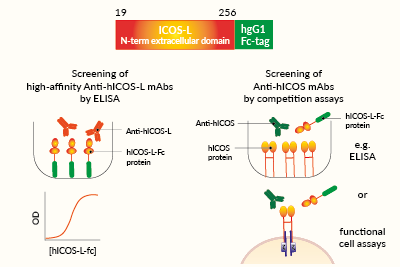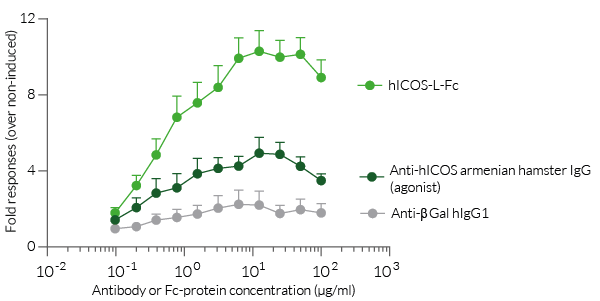Recombinant Human ICOS-L-Fc Fusion Protein
| Product | Unit size | Cat. code | Docs. | Qty. | Price | |
|---|---|---|---|---|---|---|
|
hICOS-L-Fc Soluble human ICOS-L fused to an IgG1 Fc domain |
Show product |
50 µg |
fc-hicosl
|
|
Soluble human ICOS-L (CD275) fused to an IgG1 Fc domain

Potential applications of soluble hICOS-L-Fc protein
Protein description
 InvivoGen also offers:
InvivoGen also offers:
• Anti-IC cell-based assays (Bio-IC™)
• IC-expressing cell lines
InvivoGen offers hICOS-L-Fc, a soluble human ICOS-L (CD275) chimera protein generated by fusing the N-terminal extracellular domain of human ICOS-L (aa 19-256) to the N-terminus of a human IgG1 Fc domain with a TEV (Tobacco Etch Virus) sequence linker.
hICOS-L-Fc has been produced in CHO cells and purified by affinity chromatography. It has an apparent molecular weight of ~70 kDa on an SDS‑PAGE gel.
ICOS-L background
Inducible Co-Stimulator Ligand (ICOS-L), also known as cluster of differentiation 275 (CD275) is a Type I transmembrane protein that is mostly expressed by antigen-presenting cells. ICOS-L is classified as an immunostimulatory immune checkpoint. It binds ICOS (CD278) which is rapidly induced in CD4+ and CD8+ T cells upon their activation [1].
Applications
- Screening of high-affinity anti-human ICOS-L monoclonal antibodies by ELISA
- Screening of anti-human ICOS monoclonal antibodies using competition assays
Quality control
- Size and purity confirmed by SDS-PAGE
- Protein validated by ELISA using an anti-hICOS-L monoclonal antibody
- Protein validated by flow cytometry using Jurkat-Lucia™ hICOS cells
- Protein potency at triggering intracellular signaling validated using Jurkat-Lucia™ hICOS cells
Reference
1. Amatore F et al. 2020. Role of ICOS in cancer immunotherapy. Expert Opin Biol Ther 20:141-150.
Back to the topSpecifications
Protein construction: N-terminal extracellular domain of human ICOS-L (aa 19-256) with a C-terminal human IgG1 Fc tag
Accession sequence: NP_001382847.1
Species: Human
Source: CHO cells
Tag: C-terminal human IgG1 Fc
Total protein size: 482 a.a (secreted form)
Molecular weight: ~70 kDa (SDS-PAGE)
Purification: Protein G affinity chromatography
Purity: >94% (SDS-PAGE)
Quality control:
- The protein has been validated by ELISA upon incubation with an anti-hICOS-L monoclonal antibody.
- The protein has been validated by flow cytometry using Jurkat-Lucia™ hICOS cells.
- The potency of hICOS-L-Fc at triggering intracellular signaling has been validated using Jurkat-Lucia™ hICOS cells.
- The absence of bacterial contamination (e.g. lipoproteins and endotoxins) has been confirmed using HEK-Blue™ TLR2 and HEK-Blue™ TLR4 cellular assays.
Contents
- 50 μg of lyophilized hICOS-L-Fc protein
- 1.5 ml of endotoxin-free water
![]() The product is shipped at room temperature.
The product is shipped at room temperature.
![]() Lyophilized protein should be stored at -20 ̊C.
Lyophilized protein should be stored at -20 ̊C.
![]() Resuspended protein is stable for up to 1 month when stored at 4°C, and 1 year when stored at -20°C
Resuspended protein is stable for up to 1 month when stored at 4°C, and 1 year when stored at -20°C
Avoid repeated freeze-thaw cycles.
Back to the topDetails
Inducible Co-Stimulator Ligand (ICOS-L), also known as cluster of differentiation 275 (CD275) is a transmembrane protein that is mostly expressed by antigen-presenting cells. ICOS-L is classified as an immunostimulatory immune checkpoint. It binds ICOS (CD278) which is rapidly induced in CD4+ and CD8+ T cells upon their activation [1]. The interaction between ICOS and ICOS-L delivers a secondary co-stimulatory signal through the activation of the transcription factor AKT, which promotes T cell proliferation and differentiation as well as the production of cytokines [1]. In tumor immunity, ICOS is involved in the amplification of the anti-tumor cytotoxic CD8+ T cell response, as well as the 'pro-tumor' function and maintenance of regulatory T cells (Tregs). Therefore, both agonistic and antagonistic monoclonal antibodies (mAbs) targeting this pathway are being investigated in combinational cancer immunotherapy [2]. Notably, ICOS agonistic mAbs have been shown to potentiate the effects of anti-CTLA4 mAbs [3].
References:
1. Amatore, F. et al. 2020. Role of ICOS in cancer immunotherapy. Expert Opin Biol Ther 20, 141-150.
2. Solinas, C. et al. 2020. The rationale behind targeting the ICOS-ICOS ligand costimulatory pathway in cancer immunotherapy. ESMO Open 5.
3. Soldevilla, M.M. et al. 2019. ICOS Costimulation at the Tumor Site in Combination with CTLA-4 Blockade Therapy Elicits Strong Tumor Immunity. Mol Ther 27, 1878-1891.












